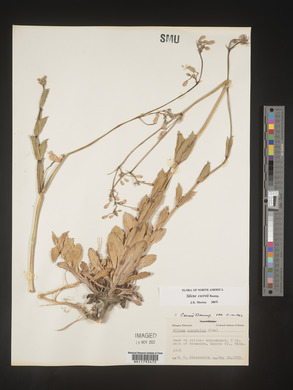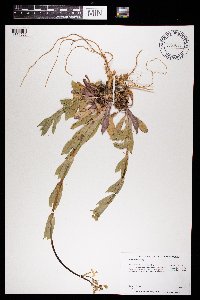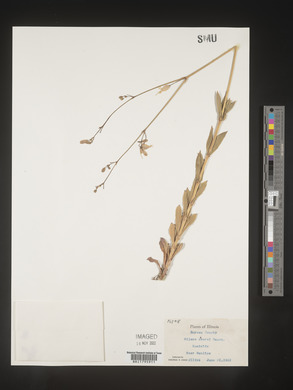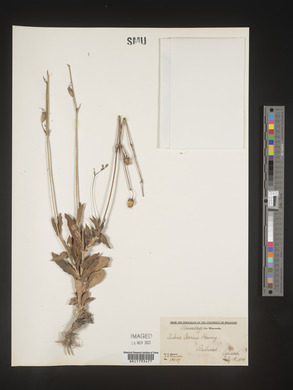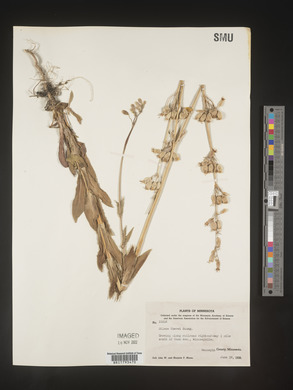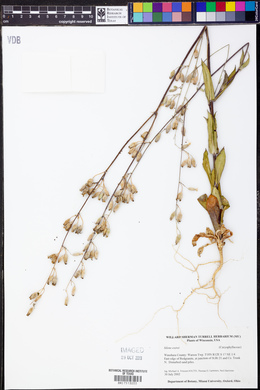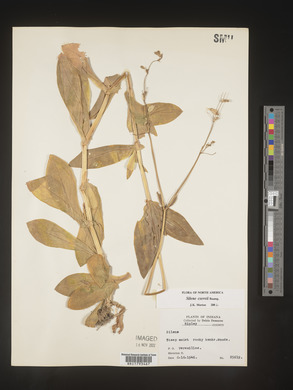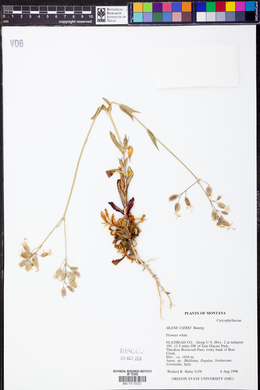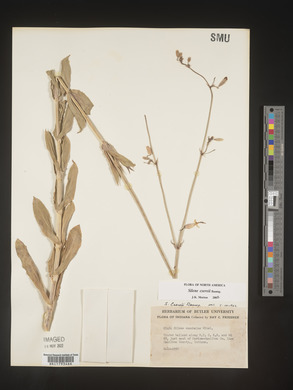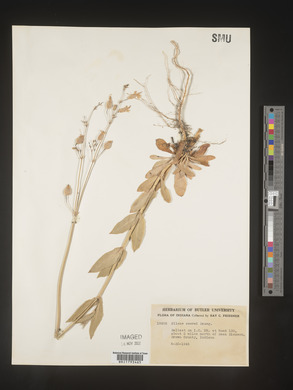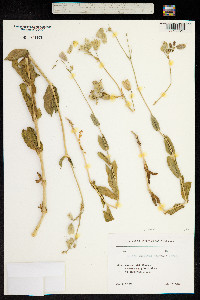Silene csereii
|
|
|
|
Family: Caryophyllaceae
Balkan Catchfly, more...biennial campion
[Silene cserei Baumg.] |
Plants annual or biennial, gla-brous and somewhat glaucous; tap-root stout. Stems erect, sparingly branched below inflorescence, robust, to 65 cm. Leaves: basal few, usually withering by time of anthesis, blade spatulate; cauline numerous, 2 per node, blade 1-veined, ovate-lanceolate to oblan-ceolate, 3-7 cm × 7-30 mm, margins entire, apex acute. Inflorescences many-flowered, open, bracteate; primary branches racemose, elongate, with sessile or shortly pedunculate cymes of 1-6 flowers per node; bracts narrowly lanceolate, 3-12 mm, hyaline-margined, apex acute. Pedicels ascending, ± straight, 1-2 times calyx, broadening at calyx base. Flowers: calyx often obscurely ca. 20-veined, elliptic, abruptly contracted at base, opening constricted to 2 its diam., slightly inflated in flower, 7-10 × 3-4 mm, in fruit tightly enveloping capsule, ovoid, thin, enlarging to 9-13 × 5-7 mm, herbaceous, margins narrow, membranous, dentate with broadly triangular lobes to 1 mm, glabrous, veins obscure, usually purple tinged, without conspicuous, pale commissures, longitudinal, parallel, not obviously reticulate; petals white, clawed, claw equaling calyx, limb deeply 2-fid into 2 spatulate lobes, to 5 mm, appendages ca. 0.5 mm; stamens exserted, to 2 times length of calyx; filaments usually dark purple; stigmas 3, exserted, to 2 times length of calyx. Capsules ovoid, equaling calyx and sometimes splitting it, opening by 6 recurved, narrowly lanceolate teeth; carpophore ca. 1 mm. Seeds grayish brown, plump, broadly reniform, 0.6-1 mm, with concentric rings of papillae; papillae slightly longer than broad. 2n = 24. Flowering summer. Cultivated fields, roadsides, waste land; 0-1600 m; introduced; Alta., B.C., Man., Ont., Que., Sask.; Colo., Conn., Idaho, Ill., Ind., Iowa, Maine, Md., Mass., Mich., Minn., Mo., Mont., N.H., N.Y., N.C., N.Dak., Ohio, Pa., S.Dak., Vt., Wash., Wis., Wyo.; Europe. Often confused with Silene vulgaris, S. csereii may be readily separated by the long, racemose primary branches of its inflorescence, the elliptic calyx that is constricted at both ends, tightly enclosing the capsule and lacking obvious reticulate venation, and the purple filaments.
Annual or biennial herb with a stout taproot to 1 m tall Stem: upright, sparingly branched below the inflorescence, with a somewhat waxy coating (glaucous). Inflorescence: an open cluster of many flowers, subtended by bracts. Primary branches elongate, with stalkless or short-stalked clusters (cymes) of one to six flowers per node. Bracts 3 - 12 mm long, narrowly lance-shaped, with thin, transparent margins. Flowers: white. Stalk ascending, more or less straight, longer than the calyx. Stamens ten, exserted, up to twice as long as the calyx. Styles three, exserted, up to twice as long as the calyx. Sepals: fused at the base into a tube (calyx). Calyx tube 7 - 13 mm long, 3 - 7 mm wide, elliptic to egg-shaped, constricted at the base, 20-veined (ten long, ten short), with short lobes. Lobes usually tinged purple, to 1 mm long, and broadly triangular. Petals: five, white, 3.5 - 6 mm long, clawed, two-lobed. Lobes spatula-shaped. Claw equal to calyx. Fruit: a dehiscent capsule, three-chambered, opening by six recurved teeth, equal to calyx, egg-shaped, tightly enveloped by calyx. Seeds grayish brown, to 1 mm long, broadly kidney-shaped, plump, roughened. Basal leaves: few, often withering by flowering time, spatula-shaped, thick, with a somewhat waxy coating (glaucous). Stem leaves: numerous, opposite, two per node, clasping, 3 - 7 cm long, 0.7 - 3 cm wide, egg- lance-shaped to reverse lance-shaped with a pointed tip, one-veined, thick, with a somewhat waxy coating (glaucous). Similar species: No information at this time. Flowering: late May to early October Habitat and ecology: Introduced from Europe. Common in waste ground, especially along railroads. Occurence in the Chicago region: non-native Etymology: Silene probably comes from the Greek word sialon, meaning saliva, referring to the sticky secretion on many of these plants. It may also have come from the word seilenos, referable to Silenus-a foam-covered, drunken character in Greek Mythology. Author: The Morton Arboretum A related biennial sp. of se. Europe, is also occasionally intr. in our range. It has broadly ovate lvs and a smaller, less inflated cal, only 10-12 mm in fr, with 10 long and 10 short veins and few or no anastomosing lateral veins. Gleason, Henry A. & Cronquist, Arthur J. 1991. Manual of vascular plants of northeastern United States and adjacent Canada. lxxv + 910 pp. ©The New York Botanical Garden. All rights reserved. Used by permission. From Flora of Indiana (1940) by Charles C. Deam I have this species from Benton and Montgomery Counties. In Montgomery County, I found several large colonies in ballast, and on the right of way of the Monon Railroad about 2 miles south of New Richmond. Apparently well established here. Fassett reports a specimen from Lake County collected by Umbach which is now in the herbarium of the University of Wisconsin. I have a specimen from Lake County collected by Umbach which I am referring to this species. Charles M. Ek found it along a railroad in Howard County. …… Indiana Coefficient of Conservatism: C = null, non-native Wetland Indicator Status: N/A |
|
|
|







